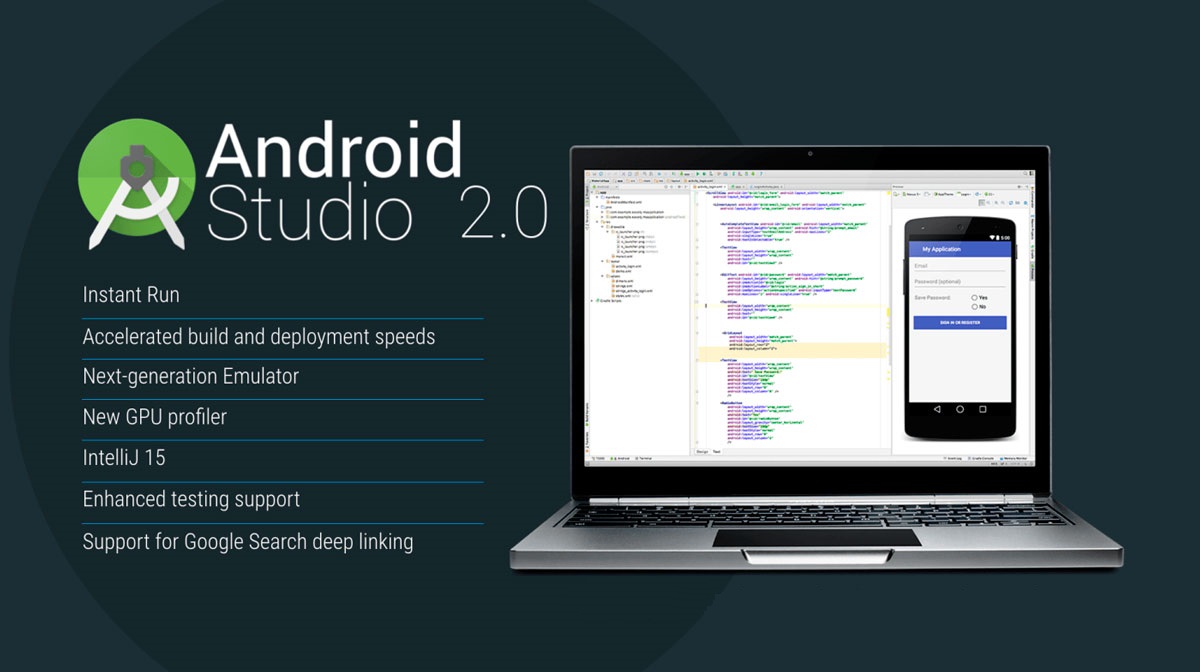Android Studio 2.0 is the fastest way to build high quality, perform-ant apps for the Android platform, including phones and tablets, Android Auto, Android Wear, and Android TV. As the official IDE from Google, Android Studio includes everything you need to build an app, including a code editor, code analysis tools, emulators and more. This new and stable version of Android Studio has fast build speeds and a fast emulator with support for the latest Android version and Google Play Services.
Android Studio is built in coordination with the Android platform and supports all of the latest and greatest APIs. If you are developing for Android, you should be using Android Studio 2.0. It is available today as a easy download or update on the stable release channel.
Android Studio 2.0 includes the following new features that Android developer can use in their workflow :
Here is the full feature Android Studio 2.0 features- Developers Preview:
Instant Run: This feature is supposed to dramatically improve your workflow by letting you quickly see changes running on your device or emulator. It lets you see your changes running “in a near instant,” which means you can continuously code and run your app, hopefully accelerating your edit, build, run cycles. When you click on the Instant Run button, it will analyze the changes you have made and determine how it can deploy your new code in the fastest way. Instant Run works with any Android Device or emulator running API 14 (Ice Cream Sandwich) or higher.
Android Emulator: The new Android Emulator is up to 3x faster in CPU, RAM, and I/O in comparison to the previous Android emulator. ADB push speeds are 10x faster. In fact, developing on the official Android Emulator is faster than a real device in most situations. It also has a new user interface and sensor controls, letting you you drag and drop APKs for quick installation, resize and rescale the window, use multi-touch actions (pinch & zoom, pan, rotate, tilt), and so on.
Cloud Test Lab: This new service allows you to test your app across a wide range of devices and device configurations. Google sees it as an extension to your testing process that lets you run through a collection of tests against a portfolio of physical devices hosted in Google’s data centers. Even if you do not have tests explicitly written, Cloud Test Lab can perform a basic set of crash tests, right from Android Studio.
App Indexing: It is now easier for your users to find your app in Google Search with the App Indexing API. Android Studio 2.0 helps you to create the correct URL structure in your app code and add attributes in your AndroidManifest.xml file that will work with the Google App Indexing service. You can then test and validate your app indexing code in Android Studio.
GPU Debugger Preview: If you are developing OpenGL ES games or graphics-intensive apps, you have a new GPU debugger (in preview) in Android Studio 2.0. It can step through your app frame by frame to identify and debug graphics rendering issues with information about the GL state.
If you are using a previous version of Android Studio, you can get the latest version in the navigation menu (Help => Check for Update on Windows/Linux and Android Studio => Check for Updates on OS X). Either download directly from the link given below:
To Download Android Studio 2.0 For Windows: Click Here (320 MB)
To Download Android Studio 2.0 For Mac: Click here (319 MB)
Mantra Labs deep dives into latest trends and innovations in the Web, Mobile, Enterprise and Internet of Things space. The insights generated from these studies helps us provide more value for our clients.
Knowledge thats worth delivered in your inbox






